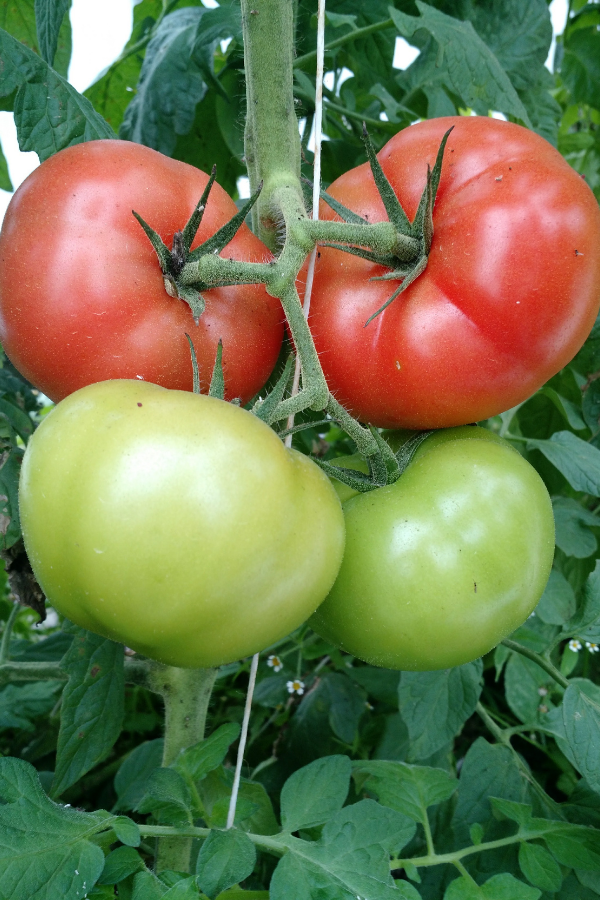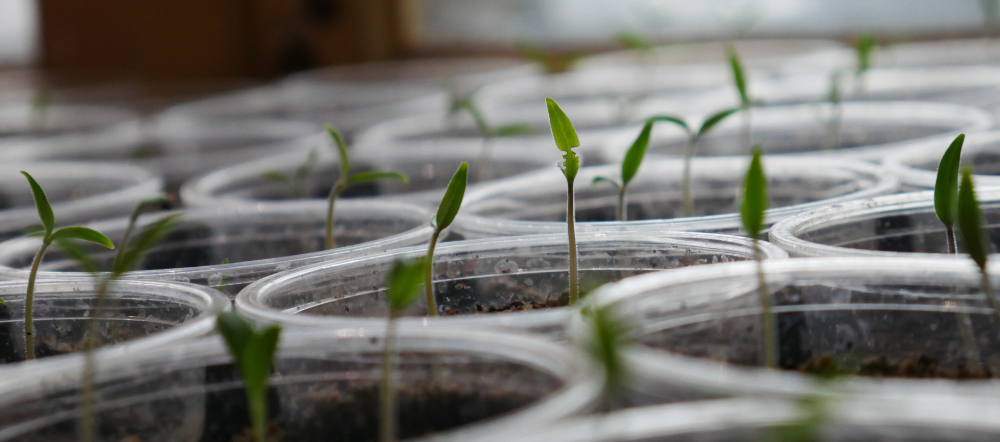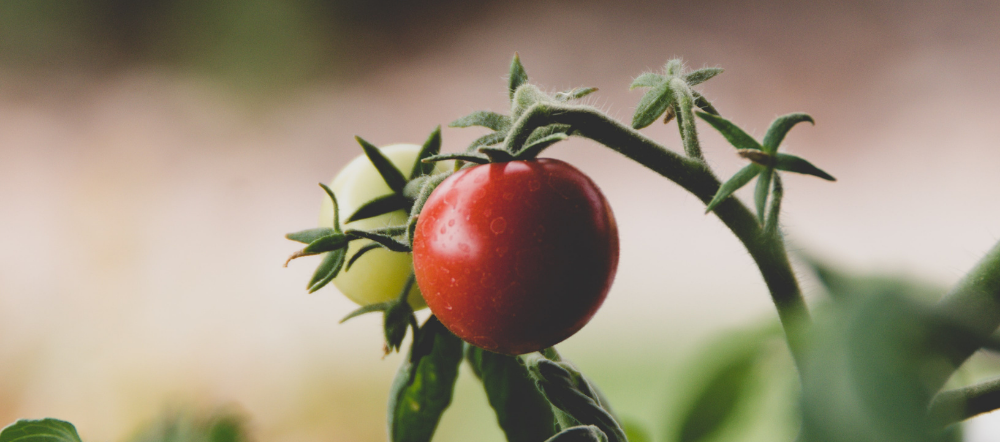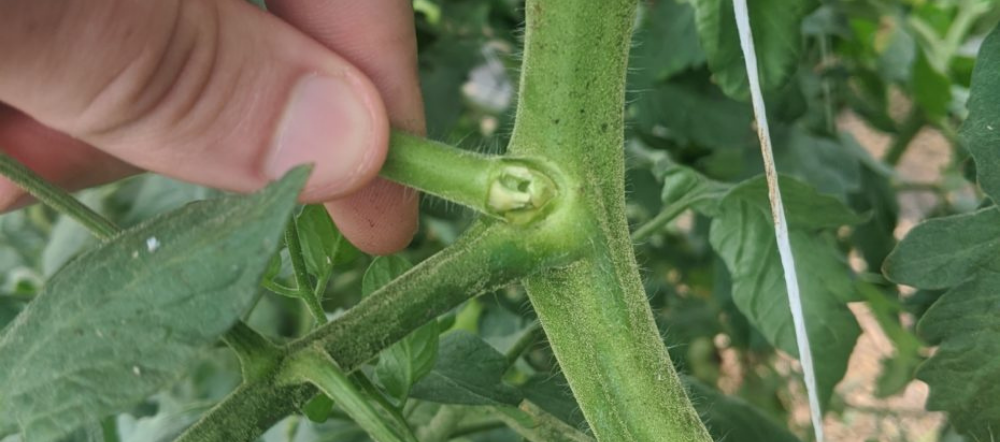Pruning plants of any kind is often necessary for a healthier plant and better harvest. Tomato plants are no different. Pruning tomato plant suckers doesn’t have to be tricky. We’re here to help you know how to prune your tomato plant in this post.
Similar to pruning other plants, tomato plant pruning isn’t a once-and-down task. To grow the healthiest tomato plant, you’ll want to prune your tomato plant throughout the summer.
We put together a guide that outlines the basics of pruning your tomato plant. Tomatoes have more strategies for pruning than other vegetable plants. There’s also a lot of preferences/techniques that gardeners will approach differently depending on the plant type. In this article, we’ll explore your options.
What is a tomato sucker?
First of all, a tomato plant sucker is the small sprout or shoot of a tomato plant that grows out from between the main stem of a tomato plant and a branch or leaf. Suckers often look like small leaflets when they are just starting off, but if left alone, they’ll grow to become hefty off-shoots that will eat up the plant’s energy and make your fruit smaller.
Sometimes, pruning tomato plants is referred to as “suckering” — this is just referring to the process of snapping or cutting off the tomato plants’ suckers.
Why pruning is recommended
Why is pruning necessary?
Tomatoes only have so much energy they receive from the sun and from the nutrients their roots take up. Ideally, you want this energy to go into delicious tomatoes for yourself rather than a bushy tomato plant.
Pruning allows you to make sure that the tomato plant is putting its energy into doing this for you. Without pruning, the tomato plant will still produce fruit, but it may not be as much or as big as it could be with pruning.
Simply put, the fewer branches and shoots the plant has to feed, the more the plant’s energy can go into producing more large fruit for yourself!
It’s also healthier for the plant to have more breathing room. Pruning helps you open the air space between branches and leaves, which help prevent disease and allows for a healthier plant to grow.
Left to itself, a tomato plant may grow bushy and straggly. Every sucker will grow into a mini branch and offshoot of the plant, which dilutes the energy the plant is using to produce fruit.

Types of tomatoes that need pruning
The degree of pruning, and the necessity of it, also depends on what type of tomato plant you are growing.
If you are growing heirloom tomatoes, for example, you most likely won’t have to prune as much, as these plants can produce large fruit, even when the plant isn’t pruned.
For tomato plants that you are growing in cages (traditional garden varieties, such as Big Beef, Mountain Spring, etc.) you will want to make sure you aren’t pruning the tomato sprout and suckers down too much. In these cases, a tomato’s branches can help brace the plant as it grows.
For tomato plants that you are tying up on a string or with a stake (in a greenhouse or anywhere else you are able to do this), you can get the most extreme with your suckering by pruning your tomato plants down to just one or two main stems. In this way, your plant will be able to invest most of its energy into producing tomatoes.
Bonus: You can also “prune” your clusters of fruit on the vine. If your tomato plant provides you with 6+ tomatoes in a cluster, you can take off a few small green tomatoes (done before the tomatoes have grown too much) — this allows the remaining tomatoes in the cluster to grow larger and grow faster as well!
When to prune your tomatoes
The best time to start pruning your tomato plants is 2-3 weeks after you plant your tomato plant in the ground. This is a time that the plant will likely begin trying to grow as much as possible, so it will be helpful for its growth to be directed into a few stems.
Below is a guide on how to prune tomatoes throughout the growing season. It’s recommended to prune your plant throughout the summer for the best harvest.

Early pruning
When pruning early in the season, try snapping or sliding off the suckers before they grow too large. Oftentimes, if you aren’t careful, a bunch of suckers will sneak by and grow into some main stems.
You can pinch off suckers that are small and immature, but you’ll want to use sheers for larger suckers.
If you already have the main stems you’d like to support and get stronger, don’t be afraid to be strict in the number of suckers you are snapping off. It’s best to be more strict early on.
When planting your tomato plant, always be careful you don’t plant it outside too early. Annuals like tomato plants are sensitive to cold spring nights.
Mid-year pruning
The mid-season is when you’ll receive the fruit of your labor from early pruning. Your main 2-3 stems will have grown and matured into strong shoots that can bear some great clusters of tomatoes.
During this time, it’s still important to be vigilant in snapping off any shoots you notice coming from the plant. The tomato plant will continue to try to grow these shoots, so if it’s more than you’d like for your tomato plant needs, do the plant a favor and snap these off.
Late pruning
Towards the end of the season is when you’ll really see the effects of either not pruning the plant enough or pruning it just right.
If you managed to keep your tomato plant to the number of main branches that you liked, and you maintained it with the proper water and fertilizer, your tomato plant will likely be healthy and great to grow fruit into the fall.
Towards the end of the tomato plant’s season, you can channel even more of the plant’s energy into producing tomatoes by snapping off the tops of the vines (where its growth has been taking place all summer). This ensures that its remaining energy is going into your final fruit, rather than growing a bigger plant.
Strategies for pruning tomatoes
Depending on your tomato plant variety, and many times, personal preference, you are going to have a different strategy for growing your tomato plant — that’s OK. Everyone’s preferences are different.
Here are a few strategies that people try when growing their tomatoes:
- Pruning down to one stem: If you are planting the tomato plant with a string to grow up or with a stake, it can be helpful to only have one main stem to maintain and grow fruit from. Of course, you’ll always have some offshoots, but doing your best to prune the plant throughout the season and keeping just one main stem can be effective to grow a healthy tomato plant.
- Pruning to a limited number of stems: Pruning to a select 2+ stems has its advantages. For one, if your main stem does happen to snap or get damaged, you have a second and third stem ready to continue to bear fruit (in the case that you only had one stem, you can wait for another sucker to grow up and be your main stem, but this can take some time and will likely delay your harvest). With 2-3 stems, the plant will have enough foliage to branch out in its cage, or whatever it’s growing in, and also enough energy to produce a large amount of fruit.
- Not pruning: For growers who want to let the plant grow to its heart’s content, you can leave the plant to decide where to place its energy. For most varieties, the plant will grow to be bushy and possibly stranggly, so this isn’t the best option for getting the largest and most tomatoes from each plant, but it’s certainly an option for someone who doesn’t have as much time to dedicate to keeping on top of the pruning. This option is optimal for heirloom tomatoes, where the fruit grows very well in a bushy plant.
What to do with suckers
After snapping off your suckers, you have a few different options on what you can do with them.
For one, the garden compost pile is a great addition.
However, if you want to have more fun with growing, you can also start additional tomato plants with these suckers you snapped off (the little suckers may be difficult to do this with, but for medium-sized (6” to a foot in size) suckers, can be placed in water to propagate. Soon, small roots will grow from the bottom of the stem, and the sucker is ready to be planted in the ground to give you some additional tomato plants.
How often to prune tomatoes
How often you prune your tomatoes is dependent on what your goals are for your plant and also what variety of tomato plant it is. Generally, if the plant is meant to be pruned, it’s good to proactively be pruning the plant throughout the season.
Since pruning a tomato plant doesn’t necessarily require any tools, any time that you check up on your plant, it can be a good habit to snap off any good-sized sucker sprouts you may see springing up.
Which shoots should be pruned off for maximum production?
Choosing which sucker shoots to snap off early on can be difficult. Typically, the main shoot is the easiest to identify.
After identifying the main tomato plant shoot, you can easily select the additional branches you would like to keep and then snap off the rest.
How to tie a tomato
To tie up your tomato, you’ll want to identify the main branch of the tomato plant and then tie a string at its base. If you’d like to keep 2-3 branches of the tomato plant, you can also tie additional strings to the base of these suckers.
Then, as the plant grows, you can keep it growing up the string with connectors, twisty ties, or additional string.
Benefits of suckering a tomato

There are many benefits of suckering a tomato plant. As mentioned before, whether or not your prune your tomato plant and the degree to which you prune it depends on the variety you are growing and how you are growing it.
For most tomato plants, the better you prune them, the better your tomato harvest is.
Here are some additional benefits of pruning your tomato plant:
- Earlier harvest. Even though the difference may only be in a few days, you will likely be able to extend your growing season just a tad with proper pruning.
- Larger fruit. The plant will tend to grow larger fruit on its existing clusters if it doesn’t have dozens of other clusters of tomatoes to supply energy to.
- More breathability for the plant. When a tomato plant has fewer branches and leaves growing, it also improves the airflow for the plant and its fruit. This can help tomatoes ripen faster. It also helps decrease the chances of disease for the tomato plant. Deadly tomato diseases like downy mildew, are more prone to attack tomato plants when the leaves and plant are dense and don’t have the airflow to dry the plant out.
How to prune a tomato plant
Pruning a tomato plant is often easy to do without even tools to aid. For the little shoots, pinching off the sucker is enough to do the job. For larger shoots, the mini branch can be snapped off by placing the index finger and thumb around the sucker shoot and bending to the side until it snaps.
For larger, more mature shoots, you’ll want to be careful. Aggressive snapping can lead to snapping the main plant’s shoot. Gently pinching the sucker branch between your fingers and moving to the side until it snaps will often do the job.
Sometimes when suckers are especially mature or thick, using pruning shears is a better method than just the fingers. Pruning sheers ensure that the plant isn’t damaged, and it will quickly and easily get the job done.
Conclusion
Pruning a tomato plant is an ongoing process that can reap great rewards for your tomato harvest. Keep in mind that plants have a limited amount of energy to put into growing and producing fruit, so be strategic about how often to prune your tomato plant.

